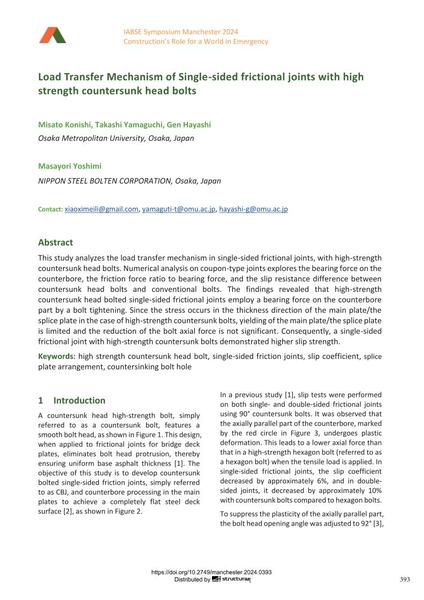Load Transfer Mechanism of Single-sided frictional joints with high strength countersunk head bolts

|
|
|||||||||||
Bibliografische Angaben
| Autor(en): |
Misato Konishi
(Osaka Metropolitan University, Osaka, Japan)
Takashi Yamaguchi (Osaka Metropolitan University, Osaka, Japan) Gen Hayashi (Osaka Metropolitan University, Osaka, Japan) Masayori Yoshimi (NIPPON STEEL BOLTEN CORPORATION, Osaka, Japan) |
||||
|---|---|---|---|---|---|
| Medium: | Tagungsbeitrag | ||||
| Sprache(n): | Englisch | ||||
| Tagung: | IABSE Symposium: Construction’s Role for a World in Emergency, Manchester, United Kingdom, 10-14 April 2024 | ||||
| Veröffentlicht in: | IABSE Symposium Manchester 2024 | ||||
|
|||||
| Seite(n): | 393-401 | ||||
| Anzahl der Seiten (im PDF): | 9 | ||||
| DOI: | 10.2749/manchester.2024.0393 | ||||
| Abstrakt: |
This study analyzes the load transfer mechanism in single-sided frictional joints, with high-strength countersunk head bolts. Numerical analysis on coupon-type joints explores the bearing force on the counterbore, the friction force ratio to bearing force, and the slip resistance difference between countersunk head bolts and conventional bolts. The findings revealed that high-strength countersunk head bolted single-sided frictional joints employ a bearing force on the counterbore part by a bolt tightening. Since the stress occurs in the thickness direction of the main plate/the splice plate in the case of high-strength countersunk bolts, yielding of the main plate/the splice plate is limited and the reduction of the bolt axial force is not significant. Consequently, a single-sided frictional joint with high-strength countersunk bolts demonstrated higher slip strength. |
||||
